1993 BUICK PARK AVENUE maintenance
[x] Cancel search: maintenancePage 11 of 340
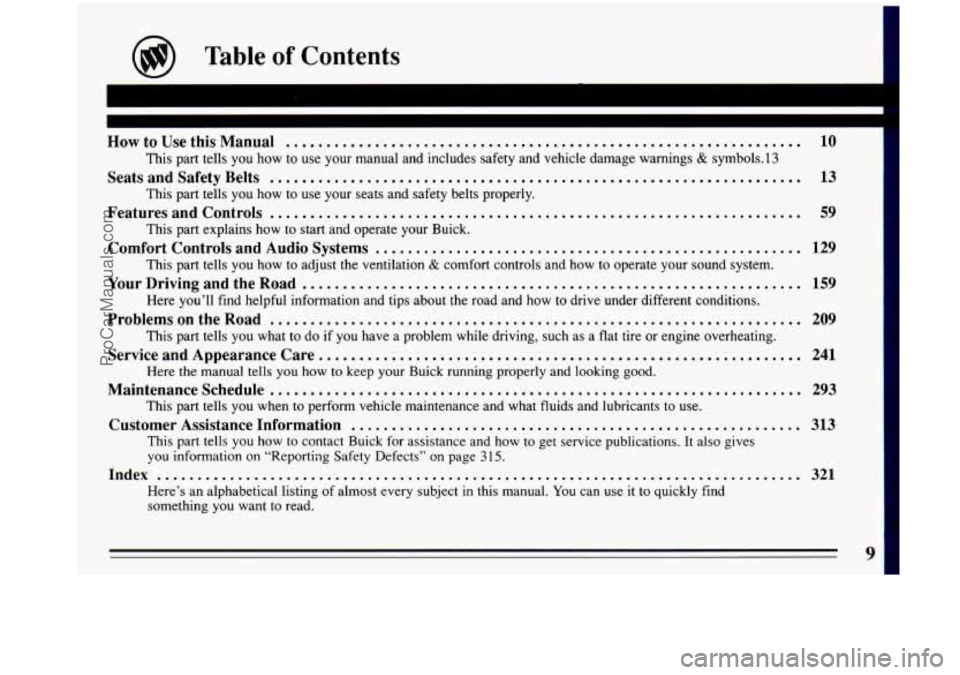
@ Table of Contents
HowtoUsethisManual ................................................................ 10 1
This part tells you how to use your manual and includes safety and vehicle damage warnings & symbols. 13
This part tells you how to use your seats and safety belts properly.
This part explains how to start and operate your Buick.
This part tells you how to adjust the ventilation
& comfort controls and how to operate your sound system.
Here you’ll find helpful information and tips about the road and how to drive under different conditions.
This part tells you what to do if you have a problem
while driving, such as a flat tire or engine overheating.
Here the manual tells you how to keep your Buick running properly and looking good.
This part tells you when to perform vehicle maintenance and what fluids and lubricants to use.
This part tells you how to contact Buick for assistance and how to get service publications. It also gives
you information on “Reporting Safety Defects” on page 315.
Here’s an alphabetical listing of almost every subject in this manual.
You can use it to quickly find
something you want to read.
SeatsandSafetyBelts .................................................................. 13
FeaturesandControls
.................................................................. 59
Comfort Controls and Audio Systems
..................................................... 129
YourDrivingandtheRoad
.............................................................. 159
ProblemsontheRoad
.................................................................. 209
Service and Appearance Care..
.......................................................... 241
Maintenanceschedule
.................................................................. 293
Customer Assistance Information
........................................................ 313
Index
........................................................................\
........ 321
ProCarManuals.com
Page 40 of 340
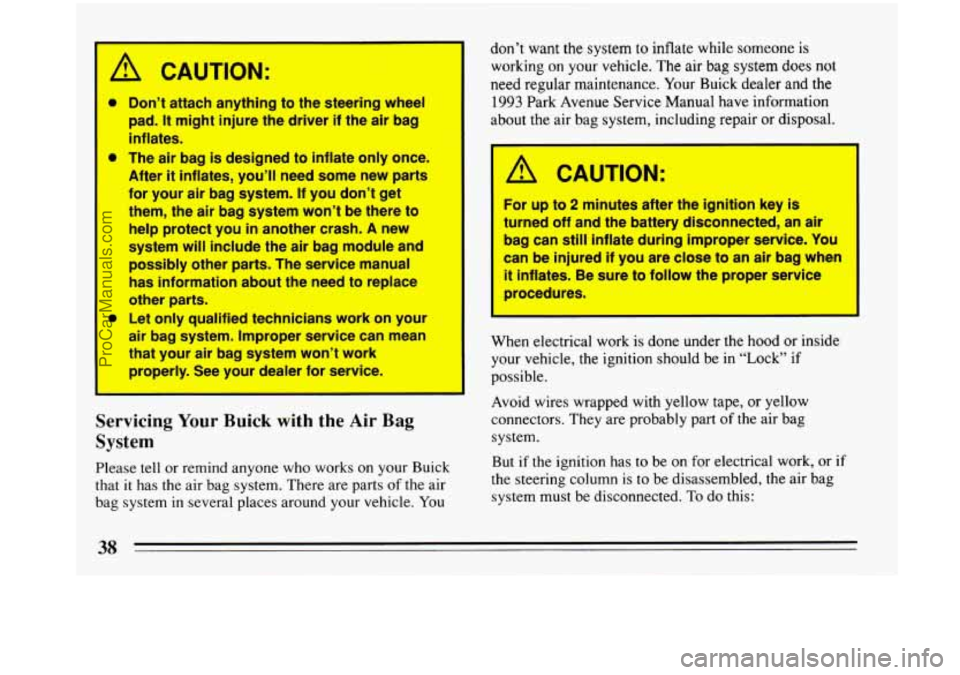
A CAUTION:
a
*
Don’t attach anything to the steering whwl
pad. It might injure the driver if the air bag
inflates.
The
air bag is designed to inflate only once.
After it inflates, you’ll need some new parts
for your air bag system. If you don’t get
them, the air bag system won’t be there to
help protect you in another crash. A new
system will include the air bag module and
possibly other
parts. The service manual
has information
about the need ta replace
other
parts.
Let only qualified technicians work on your
air bag system. Improper service can mean
that your
air bag system won’t work
properly. See your dealer for service.
I- D
Servicing Your Buick with the Air Bag
System
Please tell or remind anyone who works on your Buick
that it has the air bag system. There are parts
of the air
bag system in several places around your vehicle. You don’t want the system
to inflate
while someone is
working
on your vehicle. The air bag system does not
need regular maintenance. Your Buick dealer and the
1993 Park Avenue Service Manual have information
about the air bag system, including repair or disposal.
A CAUTION:
For up to 2 minutes after the ignition key is
turned
off and the battery disconnected, an air
bag can still inflate during improper service. You
can be injured
if you are close to an air bag when
it inflates. Be sure to follow the proper service
procedures.
When electrical work is done under the hood or inside
your vehicle,
the ignition should be in “Lock” if
possible.
Avoid wires wrapped with yellow tape, or yellow
connectors. They are probably part
of the air bag
system.
But if the ignition has to be on for electrical work, or if
the steering column is to be disassembled, the air bag
system must be disconnected.
To do this:
ProCarManuals.com
Page 163 of 340
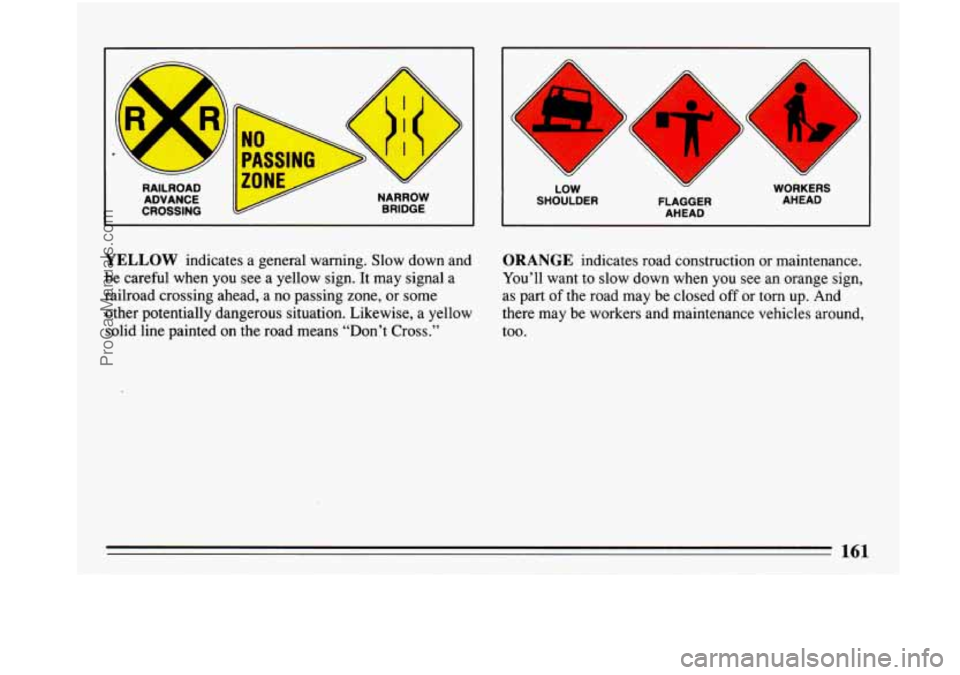
RAILROAD ADVANCE
I CROSSING
W
NARROW
BRIDGE
h
LOW WORKERS
SHOULDER FLAGGER AHEAD
AHEAD
YELLOW indicates a general warning. Slow down and
be careful when you see a yellow sign. It may signal a
railroad crossing ahead, a no passing zone, or some
other potentially dangerous situation. Likewise, a yellow
solid line painted on the road means “Don’t Cross.’’ ORANGE indicates road construction or maintenance.
You’ll want to slow down when you see an orange sign,
as part of the road may be closed
off or tom up. And
there may be workers and maintenance vehicles around,
too.
ProCarManuals.com
Page 209 of 340
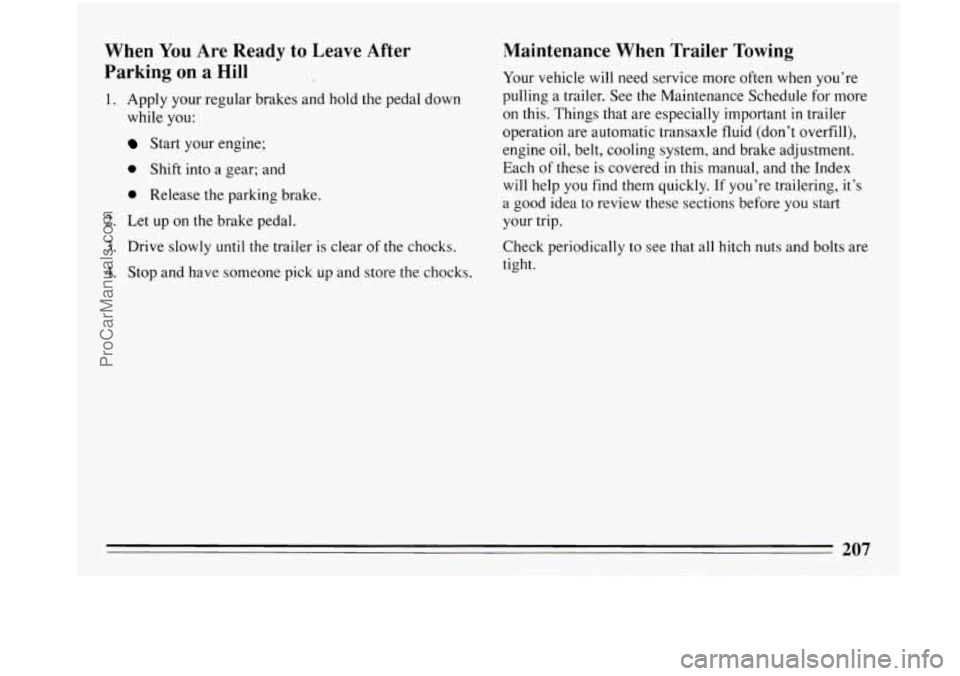
When You Are Ready to Leave After
Parking on
a Hill
1. Apply your regular brakes and hold the pedal down
while you:
Start your engine;
0 Shift into a gear; and
0 Release the parking brake.
2. Let up on the brake pedal.
3. Drive slowly until the trailer is clear of the chocks.
4. Stop and have someone pick up and store the chocks.
Maintenance When Trailer Towing
Your vehicle will need service more often when you’re
pulling a trailer. See the Maintenance Schedule for more
on this. Things that are especially important in trailer
operation are automatic transaxle fluid (don’t overfill),
engine oil, belt, cooling system, and brake adjustment.
Each
of these is covered in this manual, and the Index
will help
you find them quickly. If you’re trailering, it’s
a good idea to review these sections before
you start
your trip.
Check periodically to see that all hitch nuts and bolts are
tight.
ProCarManuals.com
Page 244 of 340
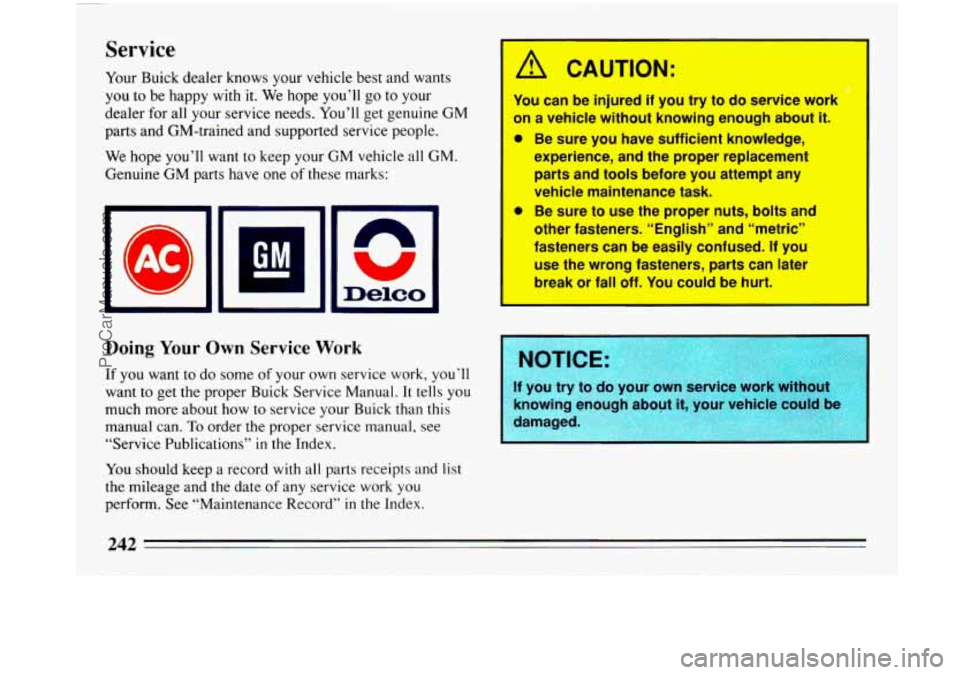
Service
Your Buick dealer knows your vehicle best and wants
you to be happy with it. We hope you’ll go to your
dealer for all your service needs. You’ll get genuine GM
parts and GM-trained and supported service people.
We hope you’ll want to keep your GM vehicle all GM.
Genuine GM parts have one
of these marks:
n
U
Delco
Doing Your Own Service Work
If you want to do some of your own service work, you’ll
want
to get the proper Buick Service Manual. It tells you
much more about how to service your Buick than this
manual can.
To order the proper service manual, see
“Service Publications’’ in
the Index.
You should keep a record with all parts receipts and list
the mileage and the date
of any service work you
perform. See “Maintenance Record’’
in the Index.
I CAUTION:
0
You can be injured if you try to do service work 1
on a vehicle without knowing enough about it.
0
I
Be sure you have sufficient knowledge,
experience, and the proper replacement
parts and tools before you attempt any
vehicle maintenance task.
Be sure
to use the proper ‘nuts, bolts and
other fasteners.
“English’a and “metric”
fasteners can be easily confused.
If you
use the wrong fasteners, parts can later
break
or fall off. You”cauld be hurt.
If you try to do your own service work
knowing enough about
it, your vehicle!l
damaged.
I
ProCarManuals.com
Page 253 of 340
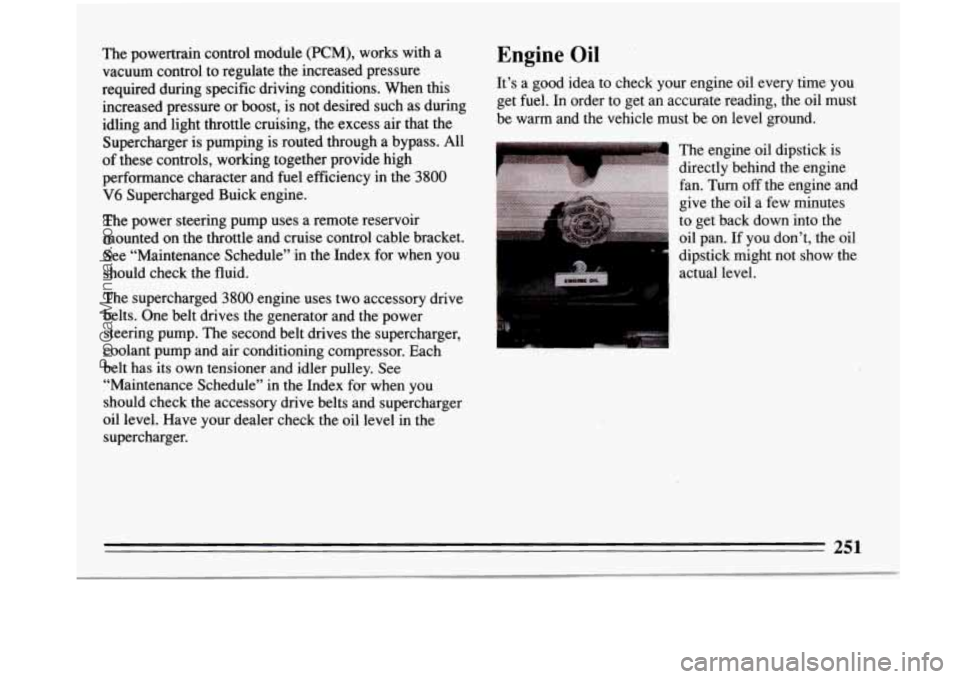
The powertrain control module (PCM), works with a
vacuum control to regulate the increased pressure
required during specific driving conditions. When this
increased pressure or boost, is not desired such as during
idling and light throttle cruising, the excess air that the
Supercharger is pumping is routed through a bypass. All
of these controls, working together provide high
performance character and fuel efficiency in the
3800
V6 Supercharged Buick engine.
The power steering pump uses a remote reservoir
mounted on the throttle and cruise control cable bracket.
See “Maintenance Schedule’’ in the Index for when you
should check the fluid.
The supercharged
3800 engine uses two accessory drive
belts. One belt drives the generator and the power
steering pump. The second belt drives the supercharger,
coolant pump and air conditioning compressor. Each
belt has
its own tensioner and idler pulley. See
“Maintenance Schedule’’ in the Index for when you
should check the accessory drive belts and supercharger
oil level. Have your dealer check the oil level in the
supercharger.
Engine Oil
It’s a good idea to check your engine oil every time you
get fuel. In order to get an accurate reading, the oil must
be warm and the vehicle must be on level ground.
The engine oil dipstick is
directly behind the engine
fan. Turn
off the engine and
give the oil a few minutes
to get back down into the
oil pan. If you don’t, the oil
dipstick might not &ow the
actual level.
ProCarManuals.com
Page 258 of 340
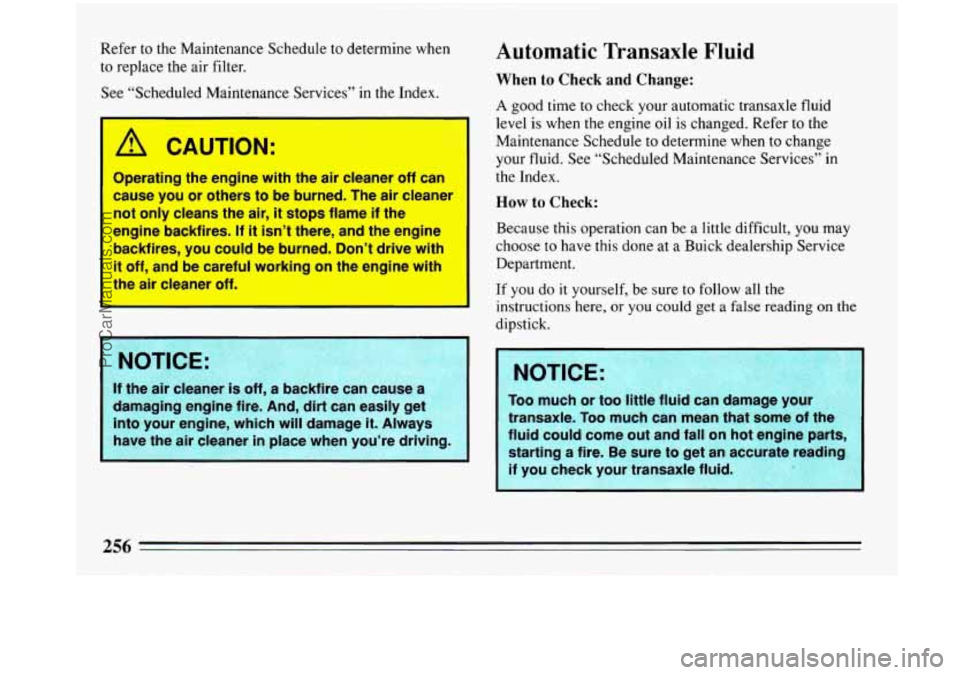
Refer to the Maintenance Schedule to determine when
to replace the air filter.
See “Scheduled Maintenance Services’’ in the Index.
A CAUTION:
Operating the engine with the air cleaner off can
cause you or others to be burned. The air cleaner
not only cleans the air, it stops flame
if the
engine backfires.
If it isn’t there, and the engine
backfires, you could be burned. Don’t drive with
it off, and be careful working on the engine with
the air cleaner off.
: NOTICE:
I If the air clean
i damaging engine fire. And, dirt can easily get
into your engine, which will damage
it. Always
’ have the air cleaner in place when you’re driving.
Automatic Transaxle Fluid
When to Check and Change:
A good time to check your automatic transaxle fluid
level is when the engine oil is changed. Refer to the
Maintenance Schedule to determine when to change
your fluid. See “Scheduled Maintenance Services” in
the Index.
How to Check:
Because this operation can be a little difficult, you may
choose to have this done at a Buick dealership Service Department.
If
you do it yourself, be sure to follow all the
instructions here, or
you could get a false reading on the
dipstick.
transaxle. Too much can mean that some of the
fluid could come out and fall on hot engine parts,
starting a fire. Be sure to get an
a
if you check your transaxle fluid.
ProCarManuals.com
Page 260 of 340
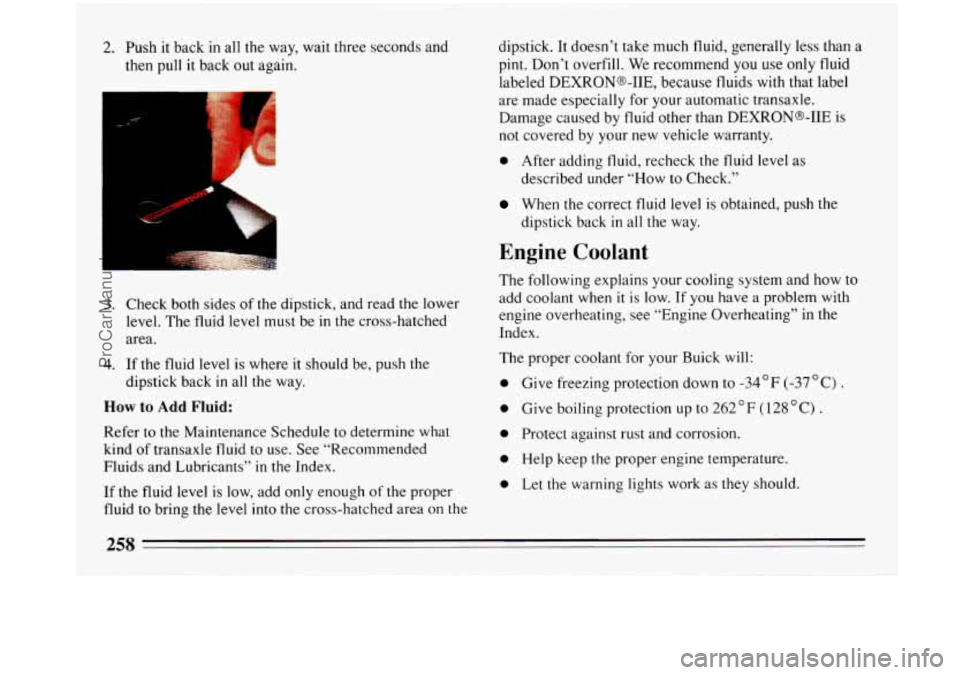
2. Push it back in all the way, wait three seconds and
then pull it back out again.
3. Check both sides of the dipstick, and read the lower
level. The fluid level must be in the cross-hatched
area.
4. If the fluid level is where it should be, push the
dipstick back
in all the way.
How to Add Fluid:
Refer to the Maintenance Schedule to determine what
kind of transaxle fluid to use. See “Recommended
Fluids and Lubricants” in the Index.
If the fluid level is low, add only enough of the proper
fluid to bring the level
into the cross-hatched area on the dipstick, It
doesn’t take much fluid, generally less than a
pint. Don’t overfill. We recommend
you use only fluid
labeled DEXRONWIE, because
fluids with that label
are made especially for your automatic transaxle.
Damage caused by fluid other than DEXRONB-IIE is
not covered by your new vehicle warranty.
0 After adding fluid, recheck the fluid level as
described under “How to Check.”
When the correct fluid level is obtained, push the
dipstick back
in all the way.
Engine Coolant
The following explains your cooling system and how to
add coolant when
it is low. If you have a problem with
engine overheating, see “Engine Overheating” in the
Index.
The proper coolant for your Buick will:
0 Give freezing protection down to -34°F (-37 “C) .
0 Give boiling protection up to 262 F ( 128 ” C) .
0 Protect against rust and corrosion.
0 Help keep the proper engine temperature.
0 Let the warning lights work as they should.
ProCarManuals.com